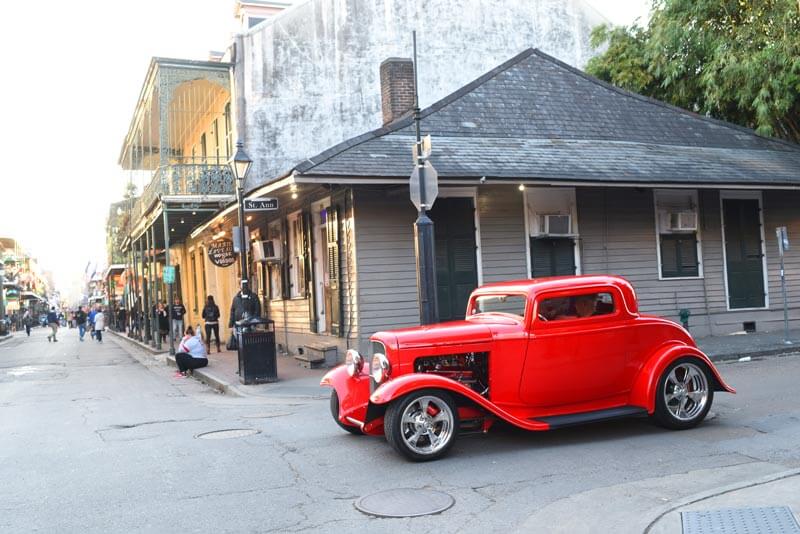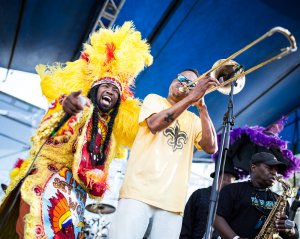Photo Ideas for Your Next French Quarter Vacation

Photo by Cheryl Gerber for FrenchQuarter.com
New Orleans is hands down one of the most photogenic places in the world. Its wrought-iron balconies and lush tropical courtyards, not to mention the craziness of Bourbon Street or the magical riverboats on the Mississippi River, would enhance anyone’s Instagram. While there’s a lot to see, do, eat, and experience during your visit, don’t forget to document your journey. Here are the best places to snap and share in the French Quarter. Pics, or it didn’t happen, right?
The French Market
This historic market was founded in 1791 as a Native American trading post and has been operating continually since, making it the oldest public market in the country. Similar in structure to a traditional European market, this open-air mall covers roughly five blocks, from Cafe Du Monde on Decatur Street across from Jackson Square to the daily flea market at the end of Esplanade Avenue.
Many retail shops and restaurants surround it in every direction. The flea market area hosts dozens of local artisans, plus vendors from all over the world. There are plenty of souvenir trinkets, belts with big fleur-de-lis buckles, cheap sunglasses, and fake gator heads, but you can also find African prints, handcrafted art objects, local music CDs, and local crafts.
French Market also includes a small pedestrian plaza on Dumaine and St. Philip streets called the Dutch Alley. The food stands at the Farmers Market Pavilion offer a slew of spices, produce and local food that is uniquely New Orleans — from pralines to oysters to the beignet mix or the hot sauce you’d want to take home.
French Quarter Courtyards
There’s no shortage of grand courtyards in the Quarter. Many of these are located on private property, but some of the Quarter’s loveliest courtyards are open to the public. They’re breathtakingly beautiful and are just begging to be photographed, while you might want to sit down and have a quiet, reflective moment to yourself.
Just to name a few, try to check out the historic gems of Prince Conti Hotel or Hotel St. Marie (this one with the pool), or the enviable open space of the Beauregard-Keyes House (also a popular wedding destination). The Court of Two Sisters and Pat O’Brien’s also both have stunning, sprawling courtyards — if you want a Hurricane or gumbo with your history lesson.
Jackson Square
Known since the 18th century as Place d’Armes, this timeless landmark was renamed in honor of Andrew Jackson following the 1815 Battle of New Orleans. Jackson’s bronze statue is the focal point of the square, surrounded by lavish flora and facing the Mississippi River. It’s perhaps one of the most recognizable images of New Orleans, along with the St. Louis Cathedral, the Cabildo, the Presbytère, and the Pontalba buildings flanking the square.
Jackson Square is also a host to the open-air artist market and performance space, with local art displayed along the fence. You can have your sketch done, dance to a brass band, or have your fortune told. Carriage rides are offered in front of the square. This bustling scene is great for experiencing and documenting!
JAX Brewery
Another unique and incredibly photogenic New Orleans landmark, JAX Brewery was once home to Jax Beer (from 1891 until the 1970s). These days this converted brewery holds a free museum devoted to brewing beer, as well as several floors of shops and restaurants. While you stroll through the beautifully renovated building, check out the view of the Mississippi River from the patio.
The Moonwalk Riverfront Park
You can access the mile-long Riverfront very easily from the Jackson Square area. There you will find the grassy Woldenberg Park and a walkway called the Moonwalk, named after the former New Orleans mayor Maurice “Moon” Landrieu. Woldenberg Park is a popular spot to watch the fireworks. It also hosts one of the largest stages during the annual French Quarter Festival, which takes place in the spring.
Stroll along the Moonwalk to view public art, like the Holocaust Memorial, and to watch the boats go by (look for classic riverboats like the Steamboat Natchez and the Creole Queen). The Riverwalk is also home to two popular family-friendly attractions, the Audubon Aquarium and the Insectarium.
Bourbon Street
That much is true: Bourbon Street is home to one of the wildest nightly street parties in the country. It’s well known for its karaoke and burlesque clubs, bars that never seem to close, and crowds milling about round the clock. It is also one of the oldest streets in the country, a vivid example of Spanish colonial architecture dating back to 1798 and steeped in history, magic, and legends. And it’s home to the city’s most iconic destinations like Galatoire’s and the Old Absinthe House (both with instantly recognizable facades).
French Quarter Balconies
The delicate, intricately woven ironwork is one of the most iconic features of New Orleans architecture. While you’ll find some stunning examples in the Garden District, the Quarter has the highest concentration of wrought iron within walking distance. You can spot it in the balconies, but also in the gates, fences, and even doors. Look for the decorative Victorian ironwork in the balconies all over the Quarter, but especially on Royal and Bourbon streets.
The French Quarter balconies are also the hotspots for the party scene, and not just during the Carnival. If you can snag an invite to a private party that takes place on the balcony, you’re lucky; otherwise, quite a few bars on Bourbon Street alone provide access to their people-watching party havens with incredible views and some bead-tossing opportunities.
Under a Historic Street Sign
We’re talking about those colorfully tiled street signs embedded into the walls throughout the Quarter, one of the most vivid reminders that the French have ceded their colony in 1763 to the Spanish and that New Orleans remained under Spanish rule till 1803. When you’re wandering around the French Quarter look for the Calle signs in Spanish, 30 total. Some correspond to the streets’ existing names, like Bourbon and Toulouse, others bear the names that are no longer: Calle Real (Royal St.), Arsenal (Ursuline), Plaza de Armas (Jackson Square), Calle del Hospital (Governor Nicholls), Camino Real y Muelle (Decatur), and so on.
Eating Beignets
The bite-sized New Orleans staple, a beignet is one of those must-haves while you’re visiting, and what better place to try it than at Cafe Du Monde, a true New Orleans fixture by the French Market that closes only for Christmas and hurricanes? Not only your plate of beignets will be served piping hot and accompanied by a strong cup of café au lait, but once you sprinkle all that powdered sugar on your beignets (and, inevitably on yourself) it becomes Instagram gold.
Almost everyone coming to New Orleans has heard of Cafe du Monde, but Cafe Beignet (with three locations in the Quarter) seems to fly under a lot of radars. We especially recommend the Royal Street location, on a quiet, pretty block where the main company is begging pigeons and sparrows.
Street Tiles
The distinct blue-and-white street tiles that spell out street names at corners throughout New Orleans are unique to the city and date back to the 1870s. While it’s not entirely clear why the city leaders have opted to embed these ceramic tiles into the sidewalks, they are admired and often photographed. The locals feel strongly about their preservation, and at least two local companies create beautiful replicas for sale (Preservation Tiles and Derby Pottery). See how many tiles you can spot while you explore the Quarter!
Art Galleries and Antique Shops on Royal Street
The 13-block thoroughfare of Royal Street that runs parallel to Bourbon is one of the finest stretches of art galleries, antique stores, wrought-iron balconies, restaurants, and some of the best and the oldest architecture in the U.S. Among the notable art galleries are Harouni, featuring the artist’s own work; and George Rodrique Studios, with the late artist’s ubiquitous Blue Dog paintings on display.
As for shopping for antiques, from exquisite chandeliers to rare 17th-century furniture to fine art and rare jewelry, Royal Street also got you covered. M.S. Rau, for instance, is considered one of the best destinations in the world for antique shopping.
Happy photo-worthy exploring!
Are you planning to spend some time in New Orleans soon? To stay close to all the action, book a historic boutique hotel in the French Quarter at FrenchQuarter.com/hotels today!





